Development, construction and commissioning of the DC-280 cyclotron of the Factory of Superheavy Elements of the FLNR JINR
Publications, 12 July 2020
The first JINR Prize for 2019 in the nomination “Scientific research, methodology, research and technology” was awarded to a team of authors comprising B. Gikal, G. Gulbekian, S. Dmitriev, I. Ivanenko, N. Kazarinov, I. Kalagin, N. Osipov, S. Pashchenko, N. Pchelkin, and V. Semin for a series of work “The development, construction and commissioning of the DC-280 cyclotron of the Factory of Superheavy Elements of the FLNR JINR”.
The discovery of new superheavy elements with Z = 114–118 has been one of the most outstanding scientific achievements of the past decade. Priority experiments were conducted in JINR (Dubna, Russia) at the accelerator complex U-400 of the Flerov Laboratory of Nuclear Reactions. Synthesis was performed in complete fusion reactions involving a double magic nucleus 48Ca and neutron-rich actinide nuclei (242,244Pu, 243Am, 249Cm, 249Bk, 249Cf).
The discovery of a new region (island) of stability and the very fact of the existence of superheavy elements raised a number of new questions related to the fundamental properties of nuclear matter. Can even heavier nuclei exist? Is the “Island of stability of SHE” the last one in the Chart of the nuclides? Can superheavy nuclei be formed in the process of nucleosynthesis like stable and long-living nuclei in the groups of Pt, Pb and U-Th were formed in Nature? Where are the boundaries of the Mendeleev’s periodic table? How much similar are the chemical properties of superheavy elements to those of their lighter homologues?
Direct synthesis of elements with Z>118 in fusion reactions means using projectiles heavier than 48Ca, since the capability of nuclear reactors to produce target material is limited to Cf isotopes. The production cross sections of nuclei with Z=120 in the 248Cm + 54Cr reaction and nuclei with Z=119 in the 249Bk + 50Ti reaction are expected to be about 10–20 times lower than that of the isotopes of SHE in experiments on the synthesis of elements 114 and 115 in reactions with 48Cа. For a more detailed study of nuclear and chemical properties of SHE, the efficiency of experiments has to be significantly improved.
The Superheavy Element Factory (SHE) Project implemented in FLNR JINR aims at addressing this task. The Factory is developed with an expected lifetime of 20–25 years and should be in demand as an experimental complex playing a leading role in studies of heavy and superheavy elements.
In 2009 the FLNR Directorate set a task of increasing ion beam intensities up to 10 pμA for ions with masses up to A=50 with a view to using them at the SHE Factory.
The U-400 cyclotron operating at FLNR since 1978 provides for the SHE synthesis the average intensity of 48Ca beams of about 1 pμA at energies of 5.3–5.7 MeV/nucleon. The total efficiency of the cyclotron (beam capture into acceleration, acceleration in cyclotron, and extraction onto a target) is about 8%. The U-400 cyclotron is equipped with the axial injection system having the electron cyclotron resonance ECR4 ion source. The beam injection potential is 12–18 kV. The capture into acceleration efficiency of 40Ar+4 and 48Ca+5 beams (ratio of current in the cyclotron center to that in the injection) without beam bunching is 5–8%. When using a system of two bunchers, the capture efficiency strongly depends on the ion source current and amounts to 30–35% for ion currents in the range of 15–18 pμA. The two-buncher system consists of a buncher with saw-tooth voltage (linear buncher) located in the upper part of the injection 4 m from the median plane of U-400 and a buncher with sinusoidal voltage in the gap (sine buncher) located 0.8 m above the median plane. Ion beams are extracted from U-400 by a charge-exchange method and pass through a thin carbon foil, the extraction efficiency of 40Ar and 48Ca being around 40%. The U-400 cyclotron has undergone numerous upgrades, which allowed experiments on SHE synthesis using beams with the intensity of 1–1.2 pμA. Further upgrade of U-400 did not guarantee an increase in the intensity by more than a factor of 2.5, thus a decision was made to create a new accelerator—DC-280 cyclotron—that would ensure the operation of the SHE Factory.
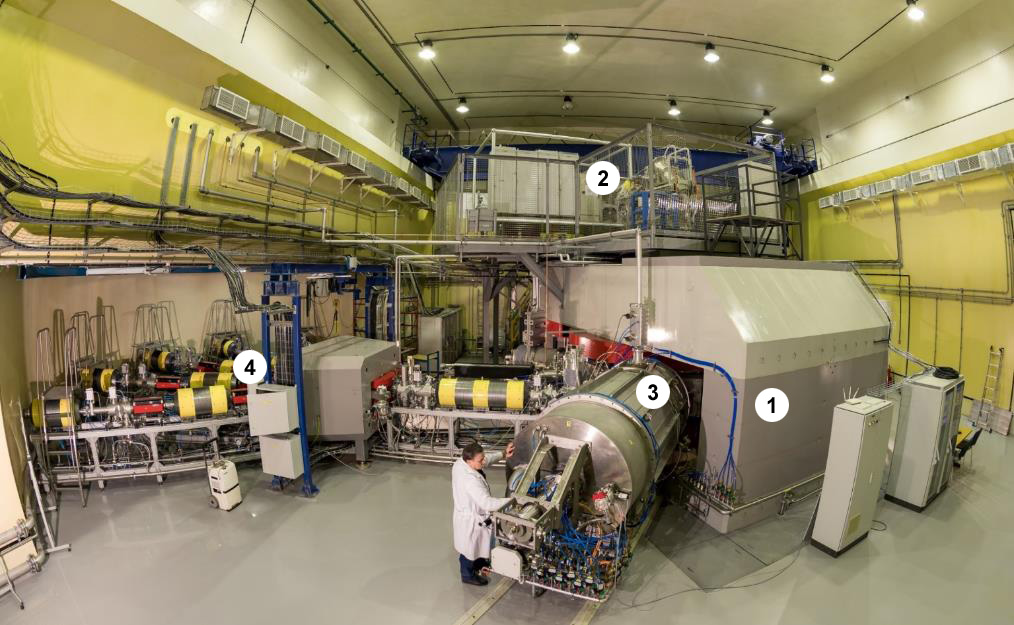 Fig. 1. DC-280 cyclotron, where 1 – main magnet of the DC-280 cyclotron, 2 – axial injection system, 3 – RF resonator, 4 – five beam transport channels.
Fig. 1. DC-280 cyclotron, where 1 – main magnet of the DC-280 cyclotron, 2 – axial injection system, 3 – RF resonator, 4 – five beam transport channels.
The DC-280 cyclotron was designed and constructed at FLNR JINR. The DC-280 Project was based both on new and experimentally proven scientific and technological expertise developed at FLNR JINR. DC-280 is an accelerator with a maximum designed beam intensity of 10 pμA on a target for ions with masses up to 50, which is one order of magnitude higher than the intensities achieved to date in long-term experiments on SHE synthesis. The development of the DC-280 cyclotron began in 2010. The main parts of the facility were manufactured by 2015 concurrently with the construction of a new experimental building of the SHE Factory, where the DC-280 cyclotron was to be placed.
Figure 2 shows the cyclotron configuration, which includes the main magnet, resonance acceleration system, beam injection system, and systems for beam extraction and transportation to physics set-ups.
The main principles that provided the basis for the DC-280 project are presented in the table below:
|
Design principles |
Expected result |
|
High injecting beam potential (up to 80 Kv) |
—Decrease in the influence of beam space charge in the injection channel. —High coefficient of beam capture into acceleration |
|
High ion acceleration rate (up to 130 kV on dees, 480 kV in a third harmonic of ion revolution frequency). Low magnetic field (up to 1.3 T) |
—Decrease in beam loss during acceleration —Good orbit separation of extracted beams, efficient beam extraction with the electrostatic deflector —Large starting radius —Reduced deflector potential |
|
Use of a flat-top system (third harmonic frequency of the RF system) |
—Low beam emittance at an extraction radius —Efficient beam extraction using the electrostatic deflector —High beam quality |
|
High gap in the center of cyclotron |
—Space for an inflector with high-potential electrodes |
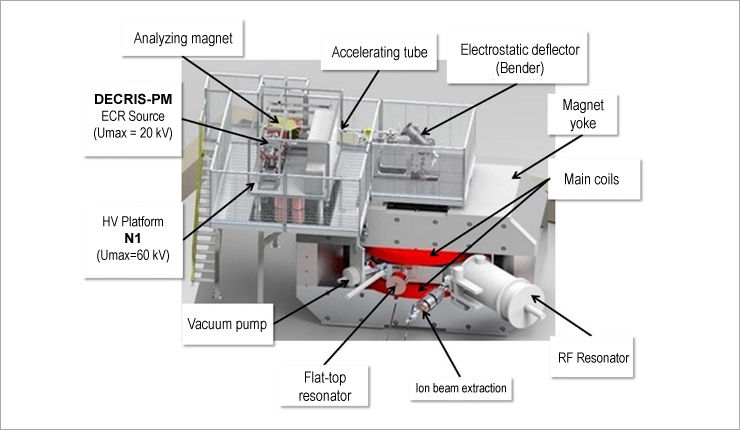 Fig. 2. DC-280 cyclotron configuration where the injection platform is located above the main magnet. The high-voltage (HV) platform is placed on another platform equipped with the DECRIS-PM ECR ion source, analyzing magnet, and beam focusing solenoid. The accelerating tube, focusing solenoid, and electrostatic spherical deflector are installed under the platform. The acceleration system of the cyclotron comprises two main dees and two flat-top dees combined with resonators.
Fig. 2. DC-280 cyclotron configuration where the injection platform is located above the main magnet. The high-voltage (HV) platform is placed on another platform equipped with the DECRIS-PM ECR ion source, analyzing magnet, and beam focusing solenoid. The accelerating tube, focusing solenoid, and electrostatic spherical deflector are installed under the platform. The acceleration system of the cyclotron comprises two main dees and two flat-top dees combined with resonators.
From 2010 to 2012 simulations and a feasibility study of the DC-280 systems were completed, their manufacture began.
The DC-280 magnetic system—main magnet, focusing sectors, and correcting coils—was simulated and designed. The magnetometer was designed for measuring the parameters of the cyclotron magnetic field after assembly.
The high-voltage injection system was simulated, and the effect of an increase in the injection energy on the efficiency of beam capture into acceleration was estimated. For 48Ca beam currents in injection over 20 pμA and at the injection potential up to 80kV, the calculated capture efficiency was over 70% – twice that for U-400. The DECRIS-PM ECR ion source with permanent magnets was developed for the HV injection. The system of rotating (magnet and spherical deflector), focusing (solenoids), and correcting components was developed for the efficient transportation of ions to the DC-280 center. The polyharmonic buncher operating in three harmonic modes (main, second and third of the RF system) was designed and simulated, providing the efficiency of beam bunching (± 20o) of the RF phase up to 80%. We determined the parameters and design of the beam chopper for forming an impulse beam structure with a pre-defined gap. The spiral inflector equipped with the electrostatic quadrupole lens at the exit was designed and simulated (Fig. 3).
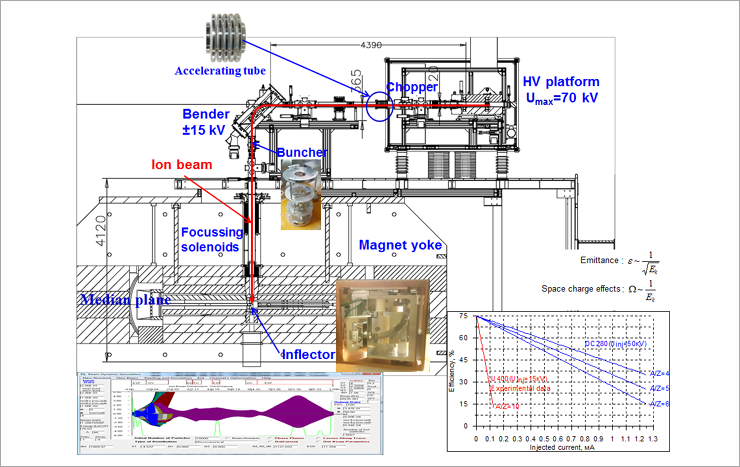 The axial injection system, where an ion beam is transported from the HV platform, accelerated in the accelerating tube, rotated into a vertical channel by the electrostatic spherical deflector (bender), and in the center of DC-280 turned into the median plane by the electrostatic spiral inflector. The beam is focused on the HV platform by the electrostatic lens and by solenoids and the electrostatic quadrupole lens behind the inflector. The figure shows the calculated beam tracing, taking into account space charge (left) and the calculated capture efficiency of ions with A/Z=4,5,6 at the injection potential of 50 kV, in comparison with U-400 (15 kV, A/Z=10).
The axial injection system, where an ion beam is transported from the HV platform, accelerated in the accelerating tube, rotated into a vertical channel by the electrostatic spherical deflector (bender), and in the center of DC-280 turned into the median plane by the electrostatic spiral inflector. The beam is focused on the HV platform by the electrostatic lens and by solenoids and the electrostatic quadrupole lens behind the inflector. The figure shows the calculated beam tracing, taking into account space charge (left) and the calculated capture efficiency of ions with A/Z=4,5,6 at the injection potential of 50 kV, in comparison with U-400 (15 kV, A/Z=10).
The acceleration system comprising 2 main dees and 2 flat-top dees with resonators was designed and simulated (Fig. 4). The parameters of RF generators were determined.
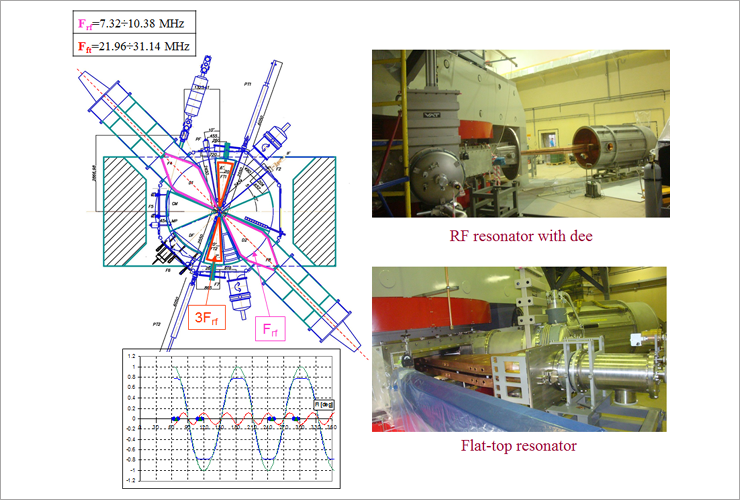 Fig. 4. RF acceleration system, where pink colour is used to indicate the main dees (angular length is 45o, working frequency is 7.32–10.38 MHz, accelerating high frequency voltage is up to 130 kV); flat-top dees are colored red (angular length is 20o, working frequency is 21.96–31.14 MHz, high frequency voltage is up to 13 kV). The figure at the bottom shows the total accelerating voltage (a blue line).
Fig. 4. RF acceleration system, where pink colour is used to indicate the main dees (angular length is 45o, working frequency is 7.32–10.38 MHz, accelerating high frequency voltage is up to 130 kV); flat-top dees are colored red (angular length is 20o, working frequency is 21.96–31.14 MHz, high frequency voltage is up to 13 kV). The figure at the bottom shows the total accelerating voltage (a blue line).
The electrostatic deflector with a gap of 1 cm operating at voltages up to 90 kV and the passive focusing magnetic channel with gradients G=4.6÷8.4 T/m were developed for the beam extraction system of DC-280 (Fig. 5).
The parameters of the beam transport channel system (5 channels), providing effective transportation of ion beams to experimental set-ups at the beam power of 2.5 kW (Fig.6), were thoroughly estimated and worked at.
The diagnostic system was developed for measuring the parameters of ion beams (intensity, profiles, energy).
The vacuum system minimizing ion loss during acceleration due to a recharge using residual gas was simulated and designed.
The digital LabView based low-level RF (LLRF) system enhancing the stability of operation of the RF system was developed.
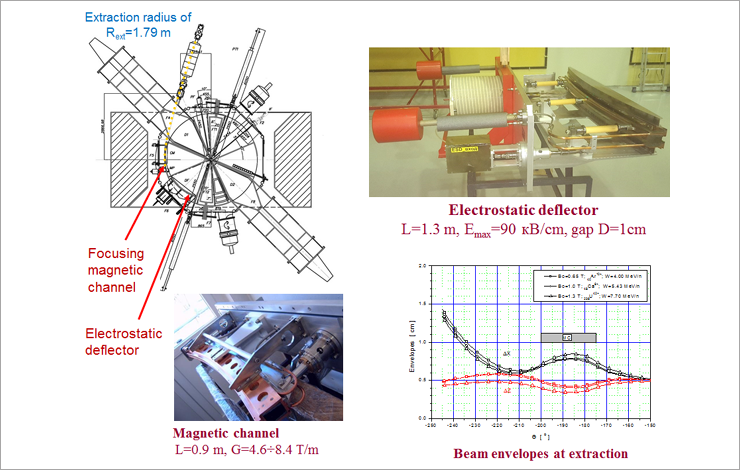 Fig. 5. Beam extraction system, electrostatic deflector, and passive focusing magnetic channel. Calculated beam envelopes behind the deflector are shown in the bottom right-hand corner.
Fig. 5. Beam extraction system, electrostatic deflector, and passive focusing magnetic channel. Calculated beam envelopes behind the deflector are shown in the bottom right-hand corner.
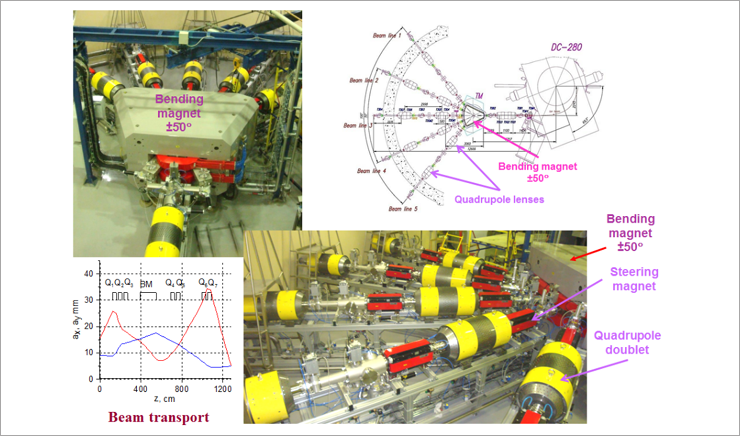 Fig. 6. Beam transport channel system used for transporting beams to physics set-ups. Calculations for the 48Ca7+ ion beam envelopes in the central channel are shown in the bottom left-hand corner.
Fig. 6. Beam transport channel system used for transporting beams to physics set-ups. Calculations for the 48Ca7+ ion beam envelopes in the central channel are shown in the bottom left-hand corner.
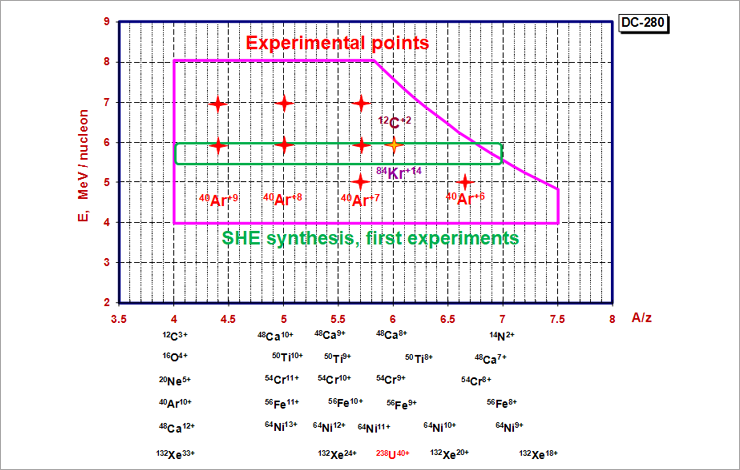 Fig. 7. Operation chart of the DC-280 cyclotron depicting the acceleration of the 84Kr+14, 12C+2, and 440Ar+6,+7,+8 ions. A region to be used in first experiments at the SHE Factory is coloured green.
Fig. 7. Operation chart of the DC-280 cyclotron depicting the acceleration of the 84Kr+14, 12C+2, and 440Ar+6,+7,+8 ions. A region to be used in first experiments at the SHE Factory is coloured green.
The installation and adjustment of the DC-280 equipment were completed in the period from 2016 to 2018. In the main magnet, the assembly accuracy was measured, magnetic measurements were taken, and the correction of the first harmonic of the magnetic field was made. The calculated and experimental results were shown to be in good agreement. Based on the measurements, a verification analysis of the beam phase behaviour during acceleration was performed.
The first beam of 84Kr14+ ions was accelerated in the DC-280 cyclotron on 26 December 2018 and extracted to the beam transport channel on 17 January 2019. Experiments on accelerating 84Kr, 12C, and 40Ar beams were performed in 2019 (Fig. 7). During the DC-280 commissioning, beams of 84Kr+14 ions with the intensity of 1.36 pμA and beams of 12C+2 ions with the intensity of 10 pμA accelerated up to 5.8 MeV/nucleon were produced. Subsequently, 40Ar+6,+7,+8 ions with energies from 5 to 7 MeV/nucleon were successfully accelerated, which allowed testing of the cyclotron central region that would be used for first experiments on SHE synthesis.
The maximum intensity of accelerated beams in a continuous wave mode was achieved for 40Ar+7 ions with the energy of 5.9 MeV/nucleon and amounted to 6 pμA. The beam extraction power was 1.4 kW. The intensity was further increased by using the chopper operating at the frequency of 150 Hz and beam duty cycle of 25% to avoid possible damages of the components of the beam extraction system during the adjustment. In this mode, we attained the intensity close to the designed one and equivalent to 9 pμA (2.1 kW).
The DC-280 cyclotron shows high values of ion capture into acceleration using the polyharmonic buncher (65–69%) for injected currents up to 21 pμA. The extraction efficiency of 40Ar+7 and 84Kr+14 by the electrostatic deflector was 79–89 % though the flat-top system was not adjusted. To date the total efficiency of capture into acceleration, total acceleration and extraction efficiency of DC-280 is 42%, which is 5 times higher than that of U-400 and will allow work with intensive beams of rare and expensive isotopes, such as 48Ca, at low substance consumption.
During the DC-280 adjustment, additional effort focused on tuning the dees. The inflector system was adjusted, defects of the control system were eliminated, the level of the working vacuum in the cyclotron chamber was improved from 3×10-7 to the designed one – 7×10-8 Torr with a beam.
In March 2019 the DC-280 cyclotron was commissioned.
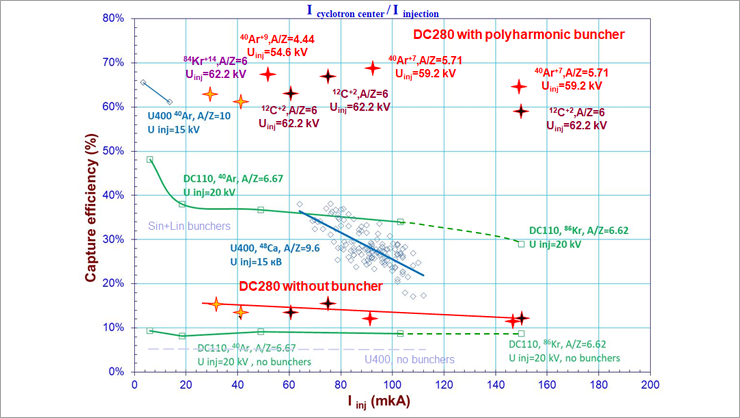 Fig. 8. Dependence of the efficiency of beam capture to acceleration on the injected ion beam current for the U-400, DC-110 and DC-280 cyclotrons with bunchers (linear and sinusoidal for U-400 and DC-110 and polyharmonic for DC-280) and without bunchers. The DC-110 cyclotron created in FLNR provides the following intensities: 2.2 pμA (40Ar+7) and 1.1 pμA (86Kr+13) with the energy of 2.5 MeV/nucleon.
Fig. 8. Dependence of the efficiency of beam capture to acceleration on the injected ion beam current for the U-400, DC-110 and DC-280 cyclotrons with bunchers (linear and sinusoidal for U-400 and DC-110 and polyharmonic for DC-280) and without bunchers. The DC-110 cyclotron created in FLNR provides the following intensities: 2.2 pμA (40Ar+7) and 1.1 pμA (86Kr+13) with the energy of 2.5 MeV/nucleon.
The main task to be fulfilled by using the new cyclotron is to implement a long-term research programme at the SHE Factory aimed at the synthesis of new (Z≥119) elements and thorough analysis of the nuclear and chemical properties of elements 112 through 118 discovered earlier. 40Ar and 48Ca beam intensities up to 5 pμA are required for testing a new gas-filled separator GFS-2 in the reactions natYb +40Ar, natYb+48Ca, 206Pb+48Ca and new rotating targets and for conducting first demonstration experiments at the SHE Factory, such as the synthesis of nuclei with Z = 115 in the 243Am + 48Ca reaction.
In September 2019 first beams 40Ar+6,+7 ions with the energy of 4.8–5 MeV/nucleon were delivered to the experimental hall for adjusting GFS-2.
In 2019 the DC-280 cyclotron operated over four months and demonstrated stable work of the main systems. The work is continued on improving the performance of all systems and aims at increasing total acceleration efficiency and beam intensity.
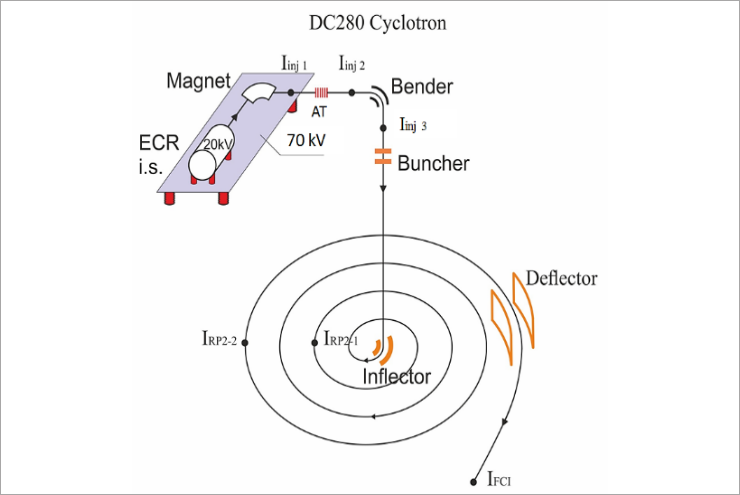 Fig. 9. Conceptual sketch of acceleration in the DC-280 cyclotron in plan view
Fig. 9. Conceptual sketch of acceleration in the DC-280 cyclotron in plan view
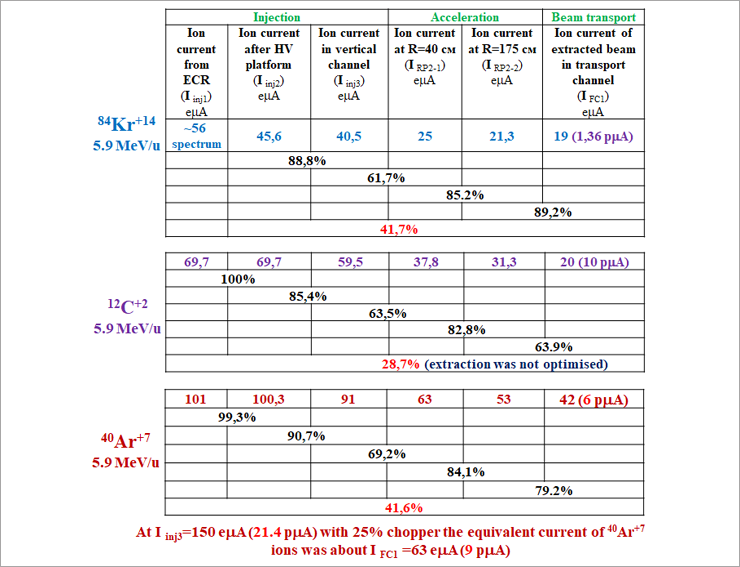 Fig. 10. Experimental results of the acceleration of the 84Kr+14, 12C+2, and 440Ar+7. The measurements of current are shown on the acceleration sketch.
Fig. 10. Experimental results of the acceleration of the 84Kr+14, 12C+2, and 440Ar+7. The measurements of current are shown on the acceleration sketch.
List of papers:
- S.N. Dmitriev, Yu.Ts. Oganessian, G.G. Gulbekyan, I.V. Kalagin, B.N. Gikal, S.L. Bogomolov, I.A. Ivanenko, N.Yu. Kazarinov, G.N. Ivanov, N.F. Osipov, S.V. Pashchenko, M.V. Khabarov, V.A. Semin, A.V. Yeremin, V.K. Utyonkov, SHE Factory: cyclotron facility for super heavy elements research // Proceedings of CYC19 Int. Conf., South Africa, Cape Town, 2019. https://cyclotrons2019.vrws.de/
- G. Gulbekian, V. Semin, I. Ivanenko, I. Kalagin, G. Ivanov, The results of magnetic field formation and commissioning of heavy- ion isochronous cyclotron DC280 // Proceedings of CYC19 Int. Conf., South Africa, Cape Town, 2019. https://cyclotrons2019.vrws.de/
- Г.Г.Гульбекян, С.Н.Дмитриев, М.Г.Иткис, Ю.Ц.Оганесян, Б.Н.Гикал, И.В.Калагин, В.А.Семин, С.Л.Богомолов, В.А.Бузмаков, И.А.Иваненко, Н.Ю.Казаринов, Н.Ф.Осипов, С.В.Пащенко, В.А.Соколов, Н.Н. Пчелкин, С.В.Прохоров, М.В.Хабаров, К.Б. Гикал., Запуск циклотрона ДЦ-280 – базовой установки Фабрики Сверхтяжелых Элементов ЛЯР ОИЯИ, принята к публикации в журнале Письма в ЭЧАЯ №6, 2019.
- Gulbekian G.G., Dmitriev S.N., Oganessian Yu.Ts., Gikal B.N., Kalagin I.V., Semin V.A., Bogomolov S.L., Ivanenko I.A., Kazarinov N.Yu., Ivanov G.N., Osipov N.F., The New DC-280 Cyclotron. Status and Road Map // Phys. Part. Nucl. Lett. 2018. V. 15, No. 7. P. 809–813.
- Kalagin I.V., Gulbekian G.G., Dmitriev S.N., Oganessian Yu.Ts., Gikal B.N., Bogomolov S.L., Ivanenko I.A., Kazarinov N.Yu., Semin V.A., Ivanov G.N., Osipov N.F., Heavy Ion Cyclotrons of FLNR JINR – Status and Plans // Proceedings of RuPAC2018. Protvino, Russia, 2018. P. 60-64.
- Kalagin I.V., Gulbekian G.G., Gikal B.N., Prokhorov S.V., Pchelkin N.N., Multigap and Polyharmonic Bunching Systems at FLNR Cyclotrons // Proceedings of RUPAC-2016. St. Petersburg, Russia, 2016. P. 446-448.
- И.В. Калагин, И.А. Иваненко, А.М. Слямов Система измерения энергии пучка ионов в циклотроне ДЦ-280 ЛЯР ОИЯИ// ЯДЕРНАЯ ФИЗИКА И ИНЖИНИРИНГ, том 6, № 9–10, 2015, с. 486–492.
- Gulbekian G., Ivanenko I., Kazarinov N., Samsonov E. Injection and Acceleration of Intense Heavy Ion Beams in JINR New Cyclotron DC280 // Proceedings of HIAT2015. Yokohama, Japan, 2015. P. 1-3.
- Гульбекян Г.Г., Гикал Б.Н., Бехтерев В.В., Богомолов С.Л., Ефремов А.А., Иваненко И.А., Казаринов Н.Ю., Калагин И.В., Мельников В.Н., Осипов Н.Ф., Прохоров С.В., Тихомиров А.В., Хабаров М.В., Проект системы аксиальной инжекции для циклотрона ДЦ-280 // Письма в ЭЧАЯ. 2014. T. 11, № 6(190). C. 1181-1186.
- Gulbekyan G.G., Gikal B.N., Ivanov G.N., Kalagin I.V., Kazacha V.I., Kazarinov N.Yu., Khabarov M.V., Melnikov V.N., Osipov N.F., Tikhomirov A.V., Teterev Y.G., The Project of the Beam Transportation Lines for the DC-280 Cyclotron at the JINR FLNR // Proceedings of RUPAC-2014. Obninsk, Russia, 2014. P. 336-338.
- Гульбекян Г.Г., Бузмаков В.А., Зарубин В.Б., Иваненко И.А., Казаринов Н.Ю., Карамышева Г.А., Франко Й., Flat-top система циклотрона ДЦ-280 // Письма в ЭЧАЯ. 2013. T. 10, № 4. C. 587-602.
- Гульбекян Г.Г., Зарубин В.Б., Карамышева Г.А., Карамышев О.В., Франко Й. Высокочастотная ускоряющая система циклотрона ДЦ-280 // Письма в ЭЧАЯ. 2012. T. 9, № 8. C. 89-97.